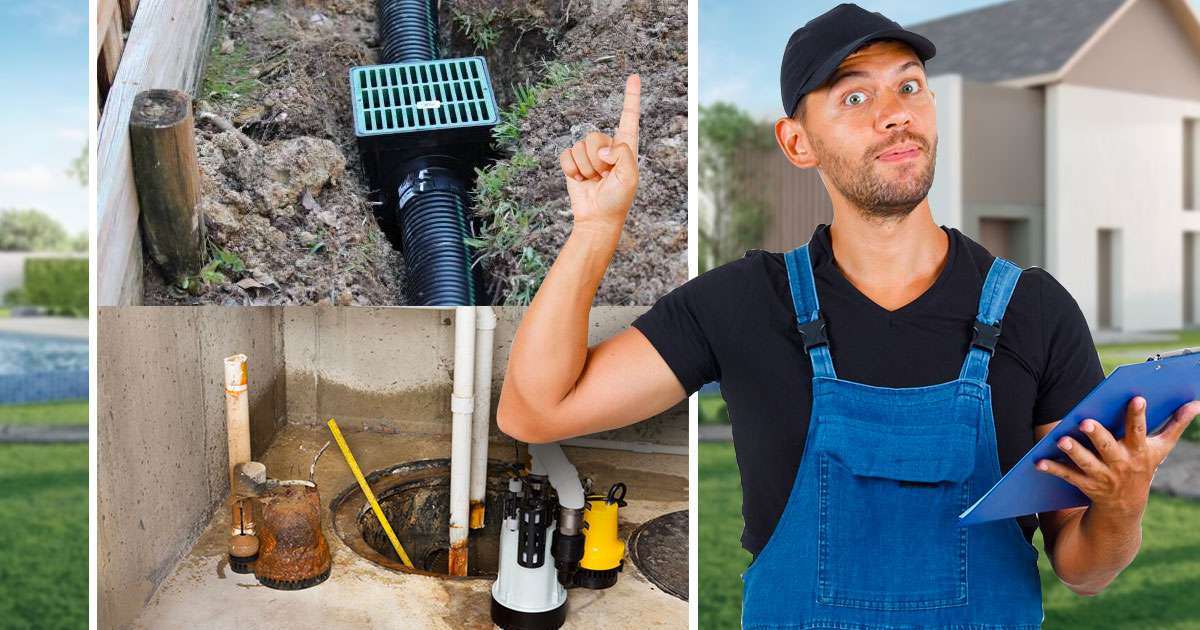French Drain vs Sump Pump: Choose the Best Waterproofing Solution

When it comes to basement waterproofing, two popular solutions often come into play: the French drain and the sump pump. Both serve as crucial elements in keeping basements dry and preventing water damage, but they operate in distinct ways. In this article, we’ll delve into the battle of a French drain vs. sump pump, discussing their functionalities and exploring how they can work hand in hand for optimal drainage.
French Drain vs. Sump Pump: Understanding the Basics
Let’s clarify what the terms “French drain” and “sump pump” mean to better understand the comparison between the two:
French Drain
A French drain is a clever solution designed to keep your home safe from water-related issues. It’s like a hidden superhero for your property. Picture a trench, like a dug-up line around your house, and inside this trench, there’s a special pipe with lots of tiny holes, surrounded by rocks or gravel. When it rains or water collects around your home, the French drain comes into action.
It grabs that extra water and guides it away from your house, preventing it from sneaking into your basement and causing problems. This smart setup helps to relieve the pressure that water can put on your home’s foundation, making sure your basement stays dry and your house remains strong. So, in simple terms, a French drain is your home’s secret weapon against water troubles.
Sump Pump
A sump pump is known as your basement’s protector against water trouble. In your basement, there’s this special hole in the ground called a sump pit, and inside it, you’ve got a trusty sump pump. Now, when it rains a lot or if there’s too much water around your house, the drainage sump pump is used. It starts pumping out the extra water from the pit, making sure your basement stays dry and doesn’t turn into a swimming pool.
So, when the rain tries to cause problems, the sump pump is like your basement’s superhero, swooping in to save the day. It’s especially useful in areas where flooding can happen or where the water level is high. In a nutshell, a sump pump is there to keep your basement safe and dry, ensuring you don’t have to worry about unexpected water surprises.
Sump Pump vs French Drain: Comparing the Two Solutions
To figure out which is better between the French drain and the sump pump, let the following aspects help you out:
Operation
French Drain: Imagine a French drain as a natural water guide in your property’s defense system. It works by letting water flow into a carefully crafted trench, and from there, a smartly designed perforated pipe takes over. Gravity and the slope of the land work together through this pipe to ensure water moves away from your home and prevent any unwelcome seepage into basements or crawl spaces.
Sump Pump: Now, think of a sump pump as your home’s watchdog against rising water levels. It stays quiet and patient in a designated sump pit in your basement. When the water level in this pit reaches a certain point, the sump pump springs into action, almost like an automatic response. It pumps out the excess water and sends it away from your home, ensuring your basement stays dry and secure.
Installation
French Drain: Installing a French drain involves a bit of groundwork. You’d need to dig around the foundation to create a trench. This process makes it an excellent choice for preventing water issues during new construction or major renovations. It’s like setting up a protective shield right from the start.
Sump Pump: On the other hand, setting up a sump pump is a bit more flexible. It doesn’t require major construction work. You create a sump pit, which can be retrofitted into existing basements. This adaptability makes the sump pump suitable for both new and established structures. It’s like adding an extra layer of protection without turning your home into a construction zone.
Key Areas of Application
French Drain: The French Drain is like a superhero for surface water. It excels at diverting rainwater and preventing groundwater from sneaking into basements or crawl spaces. It’s your go-to solution for keeping the foundation of your home safe and dry.
Sump Pump: When it comes to areas prone to flooding or with consistently high water tables, the sump pump steps in as the expert. It’s designed to handle situations where water might become a persistent challenge, making it particularly effective in regions where flooding is a concern.
In essence, the French drain and the sump pump, each with its unique strengths, work together to safeguard your home from different water-related threats, offering a comprehensive defense against potential damage.
Integrating French Drains and Sump Pumps
When it comes to basement waterproofing, the combination of a French drain in the basement with a sump pump can provide a comprehensive solution. Installing a French drain around the perimeter of the foundation can redirect water away from the structure, and coupling it with a sump pump ensures that any residual water is efficiently pumped out, further safeguarding the basement against potential flooding.
This combined strategy not only keeps your basement consistently dry but also fortifies it against the unpredictable nature of potential flooding. The French drain and sump pump have become a dynamic duo, working in harmony to provide homeowners with a comprehensive and reliable waterproofing solution, delivering peace of mind in the face of water-related uncertainties.
Which is the right waterproofing solution?
In the debate between a French drain and a sump pump, there is no one-size-fits-all solution. The choice depends on various factors, including the specific needs of the property, local groundwater conditions, and the level of protection required. While a French drain tackles water at its source, a sump pump deals with the aftermath, creating a dynamic duo for an effective basement waterproofing strategy.
Understanding the nuances between a French drain and a sump pump is crucial for making informed decisions about basement waterproofing. Whether you opt for one or both, ensuring a dry and secure basement involves thoughtful consideration of your property’s unique requirements.

